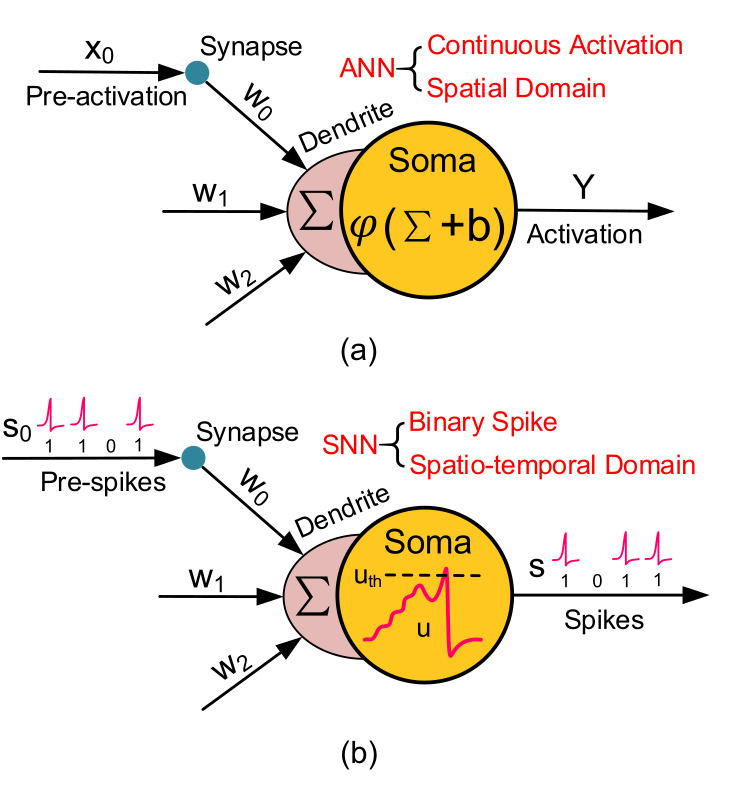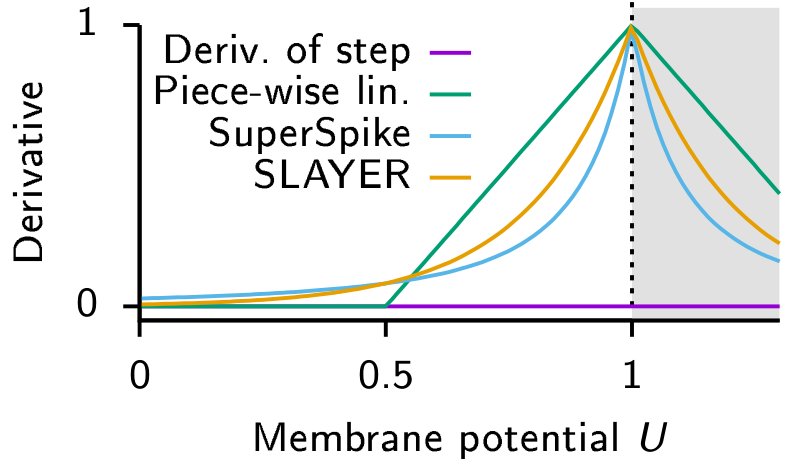Short intro to spiking neural networks#
Sparse Data Representations#
In spiking neural networks (SNN), which are labelled as the 3rd generation neural network archetype, data is represented in binary form, where a neuron can either spike or not. Every neuron has an internal state such as membrane potential, threshold and decay times. Neurons in an SNN do not fire automatically when new input is presented, but only when enough spikes per time unit accumulate so as to push the membrane potential across its threshold. The spike emitted will then be propagated forward, subject to synapse weights and delays. The sparse nature of communication offers the potential to encode and transmit information in a significantly more energy efficient manner.
Figure 1 shows the principal difference between a neuron unit in an ANN and in an SNN. Whereas the input for an ANN is typically a tensor with high data precision, but low temporal resolution, the input for an SNN are binary flags of spikes with comparatively high temporal precision in the order of s. The unit in the SNN integrates all of the incoming spikes, which affect the internal parameters such as membrane potential. The unit in the ANN merely computes the linear combination for inputs on all synapses and outputs that. Although there are ANN units with memory characteristics and internal states such as recurrent or long short-term memory units, they typically operate on much wider time frames such as a few words in a sentence or a video frame that is captured every 25 ms.

Basic neuron model in an ANN compared to an SNN. Picture taken from Deng et al. 2020.#
The development in SNNs has focused to a great extent on vision tasks such as image classification or object detection, largely driven by the need to compare new work to existing classical architectures. However, SNNs are likely not going to outperform ANNs in every aspect, but rather fill a niche. What this niche is, is an interesting research question at the moment. Some groups have developed spiking sorting algorithms, or spike time encoded addressable memory. Certainly the ability for near-sensor feature extraction, ultra-low power neural network inference, local continual learning or constraint satisfaction problems are tasks where SNNs can already excel. The stateful, recurrent architecture of RNNs also seems suitable to be mapped to SNNs.
There are other areas of artificial intelligence that are little explored when it comes to employing SNNs, such as in reinforcement learning or attention-based models. Deep reinforcement learning uses deep learning to model complex value functions for continuous high-dimensional state spaces that allows an agent to perform actions even though while training it only encountered a small subset of states during trial and error learning. Deep reinforcement learning suffers from high sensitivity to noisy, incomplete, and misleading input data and SNNs with their inherent stochastic nature could provide some robustness to that. In the same vein, ANNs are notoriously sensitive to malevolent adversarial attacks. Sharmin et al. demonstrate that SNNs tend to show more resiliency compared to ANN under black box attack scenario, which could help deploy them in real-world scenarios.
So far SNNs have not proven that they perform better in general. The rise of attention-based deep neural network architectures called transformers make it clear that time and recurrent architectures are not a necessity when computing on sequences. They allow for parallel training on multiple tokens at the same time but need lots of parameters. Transformers are causing a stir in deep learning and are being used not only in natural language processing but also vision and audio tasks. However, they work with highly dense training data such as images and regularly sampled audio files. A crucial point that neuromorphic computing relies on is sparsity. This is, after all, the strength of event-based sensing and the principle of threshold crossing. No change in the input signal means no data recorded. Nevertheless there are different training methods how an SNN can extract features from input data.
Training Spiking Neural Networks#
Training SNNs follows one of 3 major pathways: converting the weights of pre-trained ANNs, supervised learning using backpropagation with spikes or local learning rules based on STDP or other local errors. The most straightforward path to create an SNN is to convert an ANN which had previously been trained on a GPU. The idea is to trade a small impact in performance for reduced latency and power efficiency. Continuous values are hereby transformed into rate-coded schemes. Alternatively, the network can also be converted using a temporal coding scheme. Converted SNNs benefit from a large ecosystem available for GPU-based training of ANNs and certain training mechanisms such as batch normalisation or dropout.

Commonly used derivatives as a replacement for spike activation to provide a differentiable signal when training spiking neural networks. The step function has zero derivative (violet) everywhere except at 0 where it is ill defined. Examples of replacement derivatives which have been used to train SNNs are in Green: Piece-wise linear. Blue: Derivative of a fast sigmoid. Orange: Exponential. Figure taken from Neftci et al. 2019.#
In order to facilitate learning in an SNN directly, we can apply methods from classical neural network training, such as backpropagation through time, to our SNN. Since the activation of a single spike, which resembles a Dirac impulse, is not differentiable, methods resort to smoothing spike activation itself as shown in Figure 2. A recent method has also adapted backpropagation to spikes without approximations. Training methods using a global error signal achieve very good results, but are not very plausible to happen in the brain. SNNs that have been trained directly with backpropagation have yet to achieve the accuracy of converted SNNs when it comes to deeper networks, but the end-to-end training also speeds up the overall time needed for one network propagation and therefore reduces latency.
Local learning rules strive for biological plausibility without sacrificing performance too much. DECOLLE and e-prop are two recent examples of those algorithms that can both be implemented in neuromorphic hardware. Lastly, unsupervised feature extraction using local learning rules such as STDP relies purely on the timing between pre- and postsynaptic spike. It is biological plausible since it is without need for a global error signal, but has yet to reach ANN performance. The introduction of a third factor such as a global reward signal to complement the learning rule seems like a promising path forward. Overall, event-based vision promises efficient processing for naturally sparse inputs. An asynchronous network such as an SNN however needs asynchronous hardware to fully exploit its advantages.
